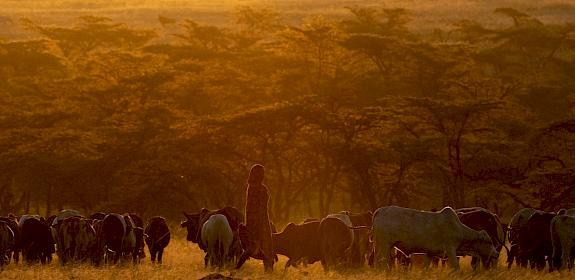Driving action to prevent decline in migratory species
Significant actions to tackle the shocking decline in many of the world’s migratory species have been agreed last week at an international meeting in Samarkand, Uzbekistan.
 The week-long meeting of the 14th Conference of the Parties of the UN Convention on Migratory Species (CMS COP14) began with the launch of the first-ever landmark State of the World’s Migratory Species report.
The week-long meeting of the 14th Conference of the Parties of the UN Convention on Migratory Species (CMS COP14) began with the launch of the first-ever landmark State of the World’s Migratory Species report.
Findings revealed a serious decline in many of the world’s migratory species, including that seven out of ten CMS-listed species are threatened by overexploitation (including intentional taking as well as incidental capture) – and shines a spotlight on species impacted by international trade as well as the significance of domestic take and trade.
This was the first COP of any global environmental treaty to take place in Central Asia – a landscape that supports many migratory species, including the Saiga Antelope and Snow Leopard.

The timely release at COP by TRAFFIC, Fauna & Flora, and partners of a trio of reports, the first-of-its-kind comprehensive analysis of wildlife trade in Central Asia, were well received. Data from a wide range of sources were compiled to demonstrate the levels and dynamics of wildlife trade in the region—both legal and illegal.
TRAFFIC, a leading global advisor on wildlife trade, joined 1,700 delegates, including 92 Government Parties, UN Agencies and over 240 participants from conservation organisations, to address the conservation needs of terrestrial, aquatic, and avian migratory species and their habitats around the world.
Important resolutions, decisions and concerted actions were adopted on over 100 topics at the COP. TRAFFIC particularly welcomed the agreement to strengthen measures to address the illegal and unsustainable taking of migratory species.
TRAFFIC welcomes actions by the CMS to more effectively address the crucial issue of illegal and unsustainable taking of wild species. We were also delighted to join the panel at a special event, ‘Dialogue and Consultation on Addressing the Illegal and Unsustainable Taking of Migratory Species for Domestic Purposes’ to advance this important agenda.”
Melanie Heath, TRAFFIC Senior Director - Global Programme Office, CMS COP14 attendee.
The COP also adopted important new decisions on critical areas of focus for TRAFFIC’s work, including Wildlife Health (encompassing the One Health agenda) and Community participation and livelihoods.
Other species-specific measures agreed upon included the new Transboundary Jaguar Initiative, advancement of the joint CITES-CMS African Carnivores initiative, and three new Action Plans for aquatic species: the Atlantic Humpback Dolphin, the Hawksbill Sea Turtle and the Angelshark.
Fourteen species in need of international conservation were added to the coverage of the Convention, including several species impacted by trade, such as the Sand Tiger Shark, the Blackchin Guitarfish, the Bull Ray, and the Lusitanian Cownose Ray. Other measures were adopted to safeguard species such as the Blue Shark, Common Guitarfish and Bottlenose Wedgefish. TRAFFIC welcomes the agreement for improved management of these species – our assessment using M-Risk, a novel method to quantify the risk posed by over-exploitation of shark stocks, supports these actions.

TRAFFIC also participated in important meetings on the sidelines of the COP, such as The Global Snow Leopard and Ecosystem Protection Programme (GSLEP) Steering Committee. The meeting reviewed actions taken by range states over the last ten years of GSLEP cooperation to address the threats, including through trade and actions for the species, as well as several meetings regarding the Saiga Antelope, both iconic migratory species in Central Asia.
This was the first major UN meeting since the adoption of the Kunming-Montreal Global Biodiversity Framework in December 2022. The CMS Strategic Plan agreed at this COP through to 2032 will play an instrumental role in delivering against the targets of the global biodiversity plan. TRAFFIC’s strategy aligns around the CBD targets that directly address the harvest, use and trade of wild species (Target 5), as well as a target that recognises the benefits to conservation and humans resulting from the legal and sustainable use of wild species (Target 9).
As with all decisions agreed upon internationally, especially those for species that migrate and transverse boundaries, delivering these nationally and locally is critical and complementarity, collaboration, and synergies between multi-lateral agreements are imperative.
“This COP’s theme ‘Nature knows No Borders’, and constructive approach and tone for the whole meeting ably demonstrated the collaborative approach needed to conserve migratory species and address drivers of their decline. TRAFFIC is committed to playing its part in this global effort and stands ready to continue to support Parties to the CMS in the conservation of migratory species, working to ensure that trade in wild species is legal and sustainable, for the benefit of people and the planet,” concluded Heath.
About the Convention on the Conservation of Migratory Species of Wild Animals (CMS)

An environmental treaty of the United Nations, the Convention on the Conservation of Migratory Species of Wild Animals (CMS) provides a global platform for the conservation and sustainable use of migratory animals and their habitats. This unique treaty brings governments and wildlife experts together to address the conservation needs of terrestrial, aquatic, and avian migratory species and their habitats around the world. Since the Convention's entry into force in 1979, its membership has grown to include 133 Parties from Africa, Central and South America, Asia, Europe and Oceania. www.cms.int
About Fauna & Flora

Fauna & Flora is a nature conservation charity protecting the diversity of life on Earth. For the survival of species and habitats, the planet and people.
As the world’s first international conservation charity, Fauna & Flora has been shaping best practice in community-focused conservation for over 120 years. Today, the charity works closely with local conservation partners in almost 50 countries to protect habitats, revive the ocean, reduce extinctions, stop illegal wildlife trade, combat climate change and influence global policy and corporate sustainability. www.fauna-flora.org





